by Larry Jordan
on August 25, 2008
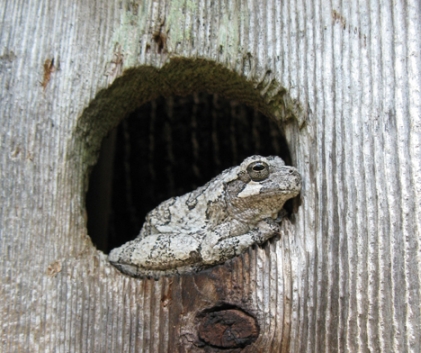
Photo from the Sand Springs Leader
This is a neat little story about a frog in a birdhouse from the Sand Springs Leader Newspaper in Arkansas. I thought it was a cool photo, plus I love frogs and have a pond in my backyard. As you know, or will find out soon, ponds and flowing water is a huge attraction for birds. The story starts like this:
It was a frog, alright; a frog in the bluebird house. Had that frog been sitting in the door-opening wearing a tam, cheap sunglasses, holding a cold drink in one hand, and a lit cigarette at the end of a long, ebony cigarette holder in the other, I wouldn’t have been more surprised.
You can read the rest of the story here: Sand Springs Leader
{ }
by Larry Jordan
on August 25, 2008
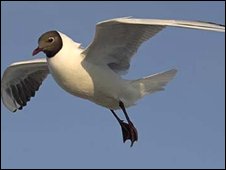
This is a news story from the BBC I thought was rather interesting as far as the legality of killing gulls with a special licence**.
“Police are investigating the suspected deliberate killings of a number of wild birds in North Yorkshire. (Image from the BBC)
Wildlife crime officers said there had been unconfirmed reports that black-headed gulls had been illegally killed in the Craven area.
The birds can be killed under the conditions of a special licence but without this it is an offence which could lead to six months in prison.
Anyone with information on the killings is being asked to contact police.
PC Vanessa Bateson, Craven wildlife crime officer, said: “It is crucial that any information about illegal killing of wild species such as black headed gulls is passed onto the police or Crimestoppers as soon as possible.”
During the past 20 years the population of the black headed gulls has fallen by 40%, which is double the decline of other gulls.”
**This is what I have discovered in researching the “Licence To Kill”. As far as I can tell, the Black-headed Gull is not on the latest species list. The entire document can be found here: Licence To Kill
Guidance Note: The licence permits authorised persons (commonly landowners and occupiers – see note j ) to carry out a range of activities against birds of the species listed. This licence may only be relied upon where the activities are carried out for the purposes of preventing the spread of disease or preventing serious damage to livestock, crops, foodstuffs for livestock, crops, vegetables, fruit, growing timber, fisheries or inland waters. This licence does not permit action to prevent damage to other forms of property or to prevent nuisance.
Persons relying on this licence must be satisfied that non-lethal methods of resolving the problem are ineffective or impracticable. Users must comply with the terms and conditions; Notes are provided as further guidance and advice on best practice.
{ }
by Larry Jordan
on August 17, 2008
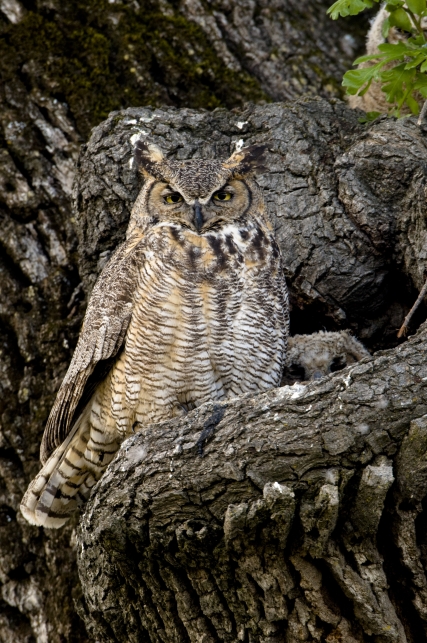
Great Horned Owl photo by Frank Kratofil
I feel so fortunate to live where I live, out in the country in rural Northern California. Although you can see this rather large owl species everywhere, it being one of the most widespread and common owls in North America.
These two photos of the Great Horned Owl were taken by my friend Frank Kratofil who is a gifted wildlife photographer in the Redding area. They were taken about 15 miles from my home but by the time I was able to get to the place where Frank had photographed the owls and their chicks, they had fledged and were no longer at the nest site. Here is another shot of the adult and the chicks.
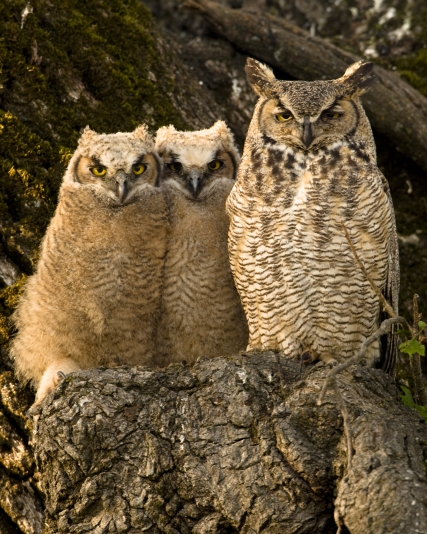
I had heard Great Horned Owls near my home but had never spotted any while out and about. The main reason being these large predators hunt mainly by night and are usually seen only roosting during the day. And as far as seeing them during the day, they are so well camouflaged, you have to look very closely near the trunks of trees for their silhouette or you would never notice them at all. Click below to hear their traditional call
[audio:https://thebirdersreport.com/audio/ghow.mp3]
[continue reading…]
{ }
by Larry Jordan
on August 6, 2008

Laysan Albatross photo by Mike Yip
Audubon Action Alert! Save Ocean Ecosystems and Their Seabirds.
The White House has recently proposed a new rule for oversight of marine fisheries. The new rule would gut the protections that the National Environmental Policy Act (NEPA) has long provided ocean ecosystems and the seabirds and other wildlife that depend on them. Under the new rule, the ability of the public to have input into the future of our oceans would be severely limited and oversight of marine fisheries would be largely given over to regional fishery management councils — the equivalent of having the fox guard the hen house.
Tell the National Marine Fisheries Service that you oppose the new rule and want to keep the National Environmental Policy Act and citizen input strong
The National Environmental Policy Act (NEPA) requires government agencies to analyze the likely environmental effects of their actions and to seek public input into their decisions. The proposed rule would exempt certain categories of fisheries from environmental review altogether and weaken the requirements for environmental reviews of fisheries across the board. The proposed new rule would also severely limit the ability of the public to give input into any decisions made.
NEPA’s review process has successfully protected ocean ecosystems in the past. By mandating that impacts to birds and other ocean wildlife be considered when fishing regulations are made, NEPA can help birds and other wildlife while creating a more sustainable ocean system. Nineteen of the twenty-two species of albatross are already threatened with extinction due to long-line fishing techniques that accidentally catch and drown the birds. On the East Coast of the United States, the rufa Red Knot is threatened by overfishing of its main food source, horseshoe crabs. It is vital for our seabirds that we do not weaken environmental oversight of the fishing industry.

Red Knot photo by Bob Sheldon
Submit a public comment opposing adoption of the new, weakened rule by the National Marine Fisheries Service.
Become a wildlife advocate. Join the “Audubon Action” and make a difference!
Happy Birding!
{ }







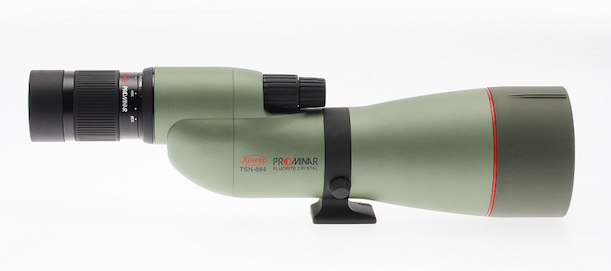


Social Media Connect